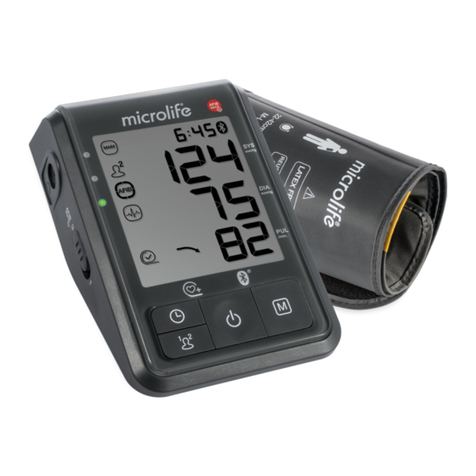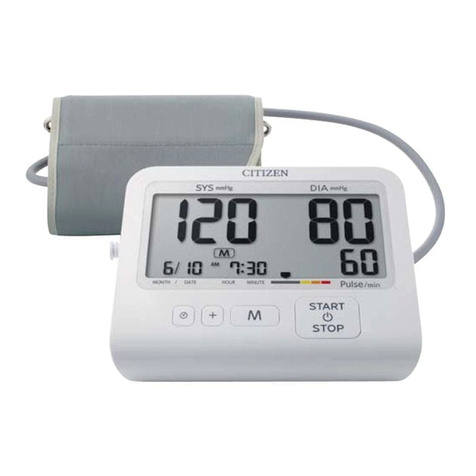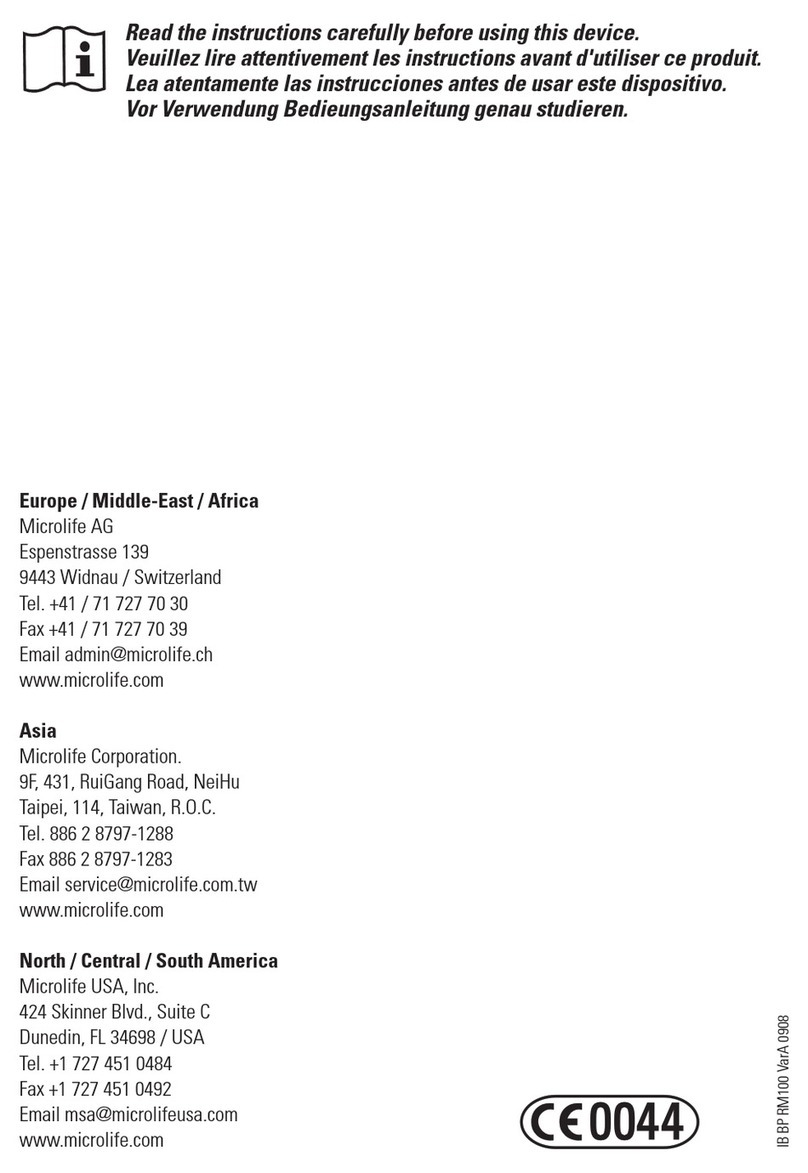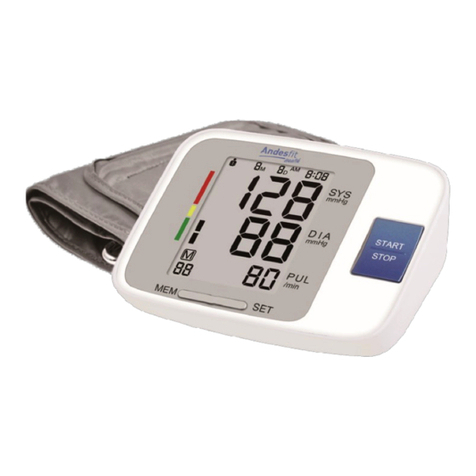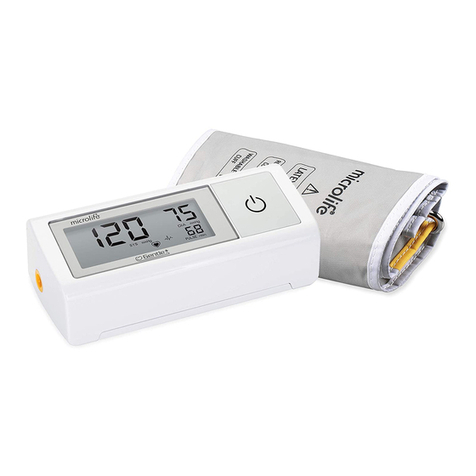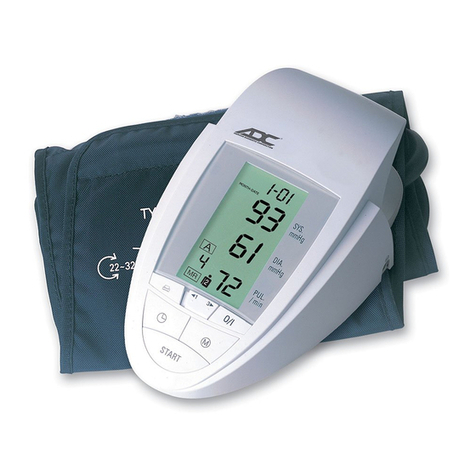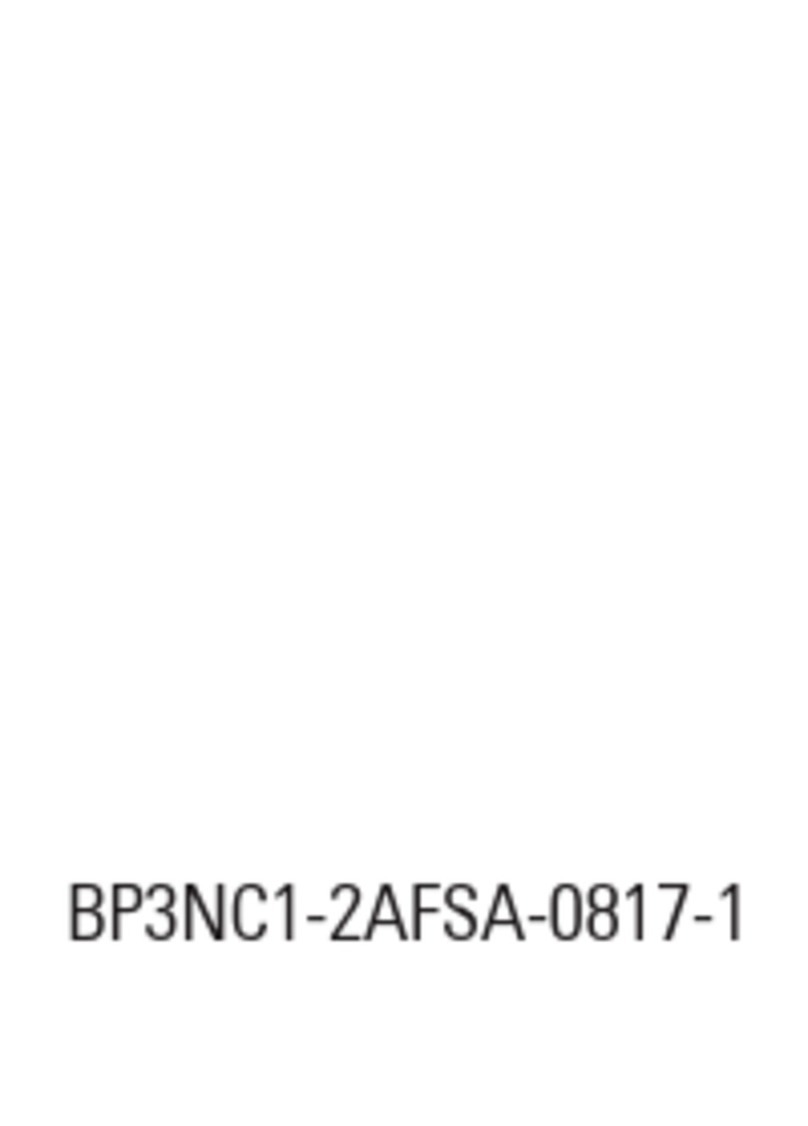Prizma PA1 User manual

Aneroid
blood pressure
measuring device
INSTRUCTION
MANUAL
PA1
0004543-8606108560891

PA1
Aneroid blood pressure measuring device
1
Dear Customer,
About this Manual
This manual contains information necessary for proper use,
maintenance, and storage of your aneroid blood pressure mea-
suring device. We recommend that you read this manual care-
fully, including warnings, contraindications and notes, before
using this device.
We wish you good health!
Your PRIZMA Kragujevac

Instruction Manual
2
Table of Contents
1. Preface ........................................................ 3
1.1 About blood pressure ...................................... 3
1.2 Blood pressure disorders ................................... 4
1.3 Proper measurement of blood pressure ..................... 4
1.4 About aneroid blood pressure measuring device.............. 5
2. Precautions for Safe Use ....................................... 6
2.1 Contraindications .......................................... 6
2.2 Warnings .................................................. 6
2.3 Caution during measurement ............................... 7
2.4 Environmental preservation and protection .................. 7
2.5 Maintenance ............................................... 8
2.6 Cleaning ................................................... 9
2.7 Storage .................................................... 9
3. Product overview ............................................. 10
3.1 Introduction .............................................. 10
3.2 Package contents ......................................... 10
3.3 Product description ....................................... 11
4. Using the product ............................................. 12
4.1 Preparation ............................................... 12
4.2 Body position during measurement ........................ 12
4.3 Placing the cuff ............................................ 13
4.4 Taking a Measurement .................................... 14
5. Troubleshooting .............................................. 16
6. Product specification .......................................... 17
7. Symbols ...................................................... 18

PA1
Aneroid blood pressure measuring device
3
1.1 About blood pressure
Blood pressure is the mechanical pressure exerted by blood on the
inner surface of arterial blood vessels. It is measured in millimeters
of mercury. Blood pressure of a human is not constant over 24 hours,
but fluctuates within the certain range. There are two components
of blood pressure:
Systolic blood pressure is the value of blood pressure that occurs
in arteries in the moment of contraction and ejection of blood from
the left ventricle into circulation.
Diastolic blood pressure refers to pressure in arteries in the moment
of ventricular relaxation.
1. Preface
Classification of arterial hypertension
ESH/ESC
category
Systolic pressure Diastolic pressure AHA/ACC
category
mmHg kPa mmHg kPa
Optimal < 120 < 15.9 < 80 < 10.5 Normal
Normal 120–129 15.9 -16,5 80–84 10.5-10,8 Prehypertension
High normal 130–139 17. 0 –18 .5 85–89 11.0–11.9 Prehypertension
Hypertension ≥140 ≥18.7 ≥90 ≥12.0 Hypertension
Stage I (mild
hypertension) 140 –159 18.7–21.2 90–99 12.0–13.2 Stage I
Stage II (moderate
hypertension) ≥160-179 ≥21.3-
24,0 ≥100-110 ≥13.3-14.3 Stage II
Stage III (severe
hypertension) ≥180 ≥24.0 ≥110 ≥14.3 Stage II
Table 1.

Instruction Manual
4
1.2 Blood pressure disorders
High blood pressure (Arterial hypertension) is defined as a condi-
tion in which either both or one component of blood pressure are
elevated above the values referred to as referent ones(Table 1).
A good control of blood pressure requires repeated blood pressure
measurements at few days’ intervals, which can be performed at your
doctor’s office or out of it. Elevated blood pressure values are often
without symptoms, which can result in a delayed diagnosis. If elevated
blood pressure values persist over prolonged period of time, they
can cause numerous complications in target organs, such as heart,
brain, and kidneys. A better control of blood pressure may reduce
the risk form sudden cardiovascular and cerebrovascular events.
Regular measurement of blood pressure is beneficial for diagnosis,
as well as for therapy control. High blood pressure in pregnancy rep-
resents a particular problem, which requires a regular monitoring
with a constant consultation with physician.
Low blood pressure (Arterial hypotension) is a condition in which
either both or one component of blood pressure are lowered bel-
low expected values. Regular monitoring of blood pressure is ben-
eficial not only for diagnosis of hypertension, but also for diagnosis
of hypotension. Hypotension may cause dizziness and loss of con-
sciousness particularly in elderly who experience deterioration of
autonomous nervous system functions during standing, after meals,
or after having bath.
1.3 Proper measurement of blood pressure
Indirect methods for measurement of blood pressure was introduced
by Korotkoff in 1905. It is still used without major modifications.
Blood pressure is measured in sitting position. Cuff should be wrapped
around upper arm, so that its edge is positioned 2 cm above the cu-
bital fossa (elbow pit). Palpate radial pulse, inflate the cuff quickly
up to 70 mmHg, and later on gradually. Note the level of pressure in
which pulse dissapears when blood vessel is completely compressed,

PA1
Aneroid blood pressure measuring device
5
and inflate cuff additionally 30 mmHg above that value. Position the
chestpiece on the spot palpated above the brachial artery. Release
the air from the cuff at speed of 2-3 mmHg per second. Once the
systolic pressure is equalized with the pressure in the cuff, the first
sounds are audible (so called Korotkoff sounds). In the moment when
they completely disappear, diastolic pressure is equalized with the
pressure in the cuff, and blood flow is again uniform. Auscultation of
those sounds is conducted in five phases, and occurrence of the first
phase that marks appearance of the sounds corresponds to value of
systolic pressure, while occurrence of the fifth phase, when sounds
disappear, represents the value of diastolic pressure.
Measurement should be repeated after half of an hour, and then
mean value of both measurements should be calculated.
Note:
•
In children, age 4 to 12, value of diastolic blood pressure is read
in the fourth phase. The fourth phase of sounds auscultation
marks transition from a clear sound to a muffled one.
•
In pregnant women, value of diastolic blood pressure is read in
the fifth phase, except in the case when air from the cuff is re-
leased and sounds are still audible, and then blood pressure is
read in the fourth phase.
1.4 About aneroid blood pressure measuring device
PA1 is an aneroid device for accurate and precise measurement of
blood pressure using manometer (pressure gauge) with a pump,
cuff and stethoscope. Measured values are read on the large and
clearly visible manometer’s scale. It is suitable for professional use
in hospitals, offices, ambulances, as well as for use in home envi-
ronment (with an adequate training and provided that instruction
for use is carefully read). A special ergonomic design allows a simple
and comfortable use with both left and the right hand. PA1 contains
a predefined cuff that allows a larger contact area, proper position-
ing and comfort. Larger contact area allows a higher reliability of the
device during blood pressure measurement.

Instruction Manual
6
2.1 Contraindications
•
DO NOT PLACE cuff on a patient’s arm receiving an intravenous
drip, because cuff inflation may cause obstruction of fluid flow
and/or injury.
•
DO NOT PLACE cuff over wounds, because cuff inflation and
pressure may cause additional injury.
•
It is not intended to place cuff and to apply pressure on an arm
where arterial-venous fistula is placed.
2.2 Warnings
Limitations of use
•
Not intended for use in newborns.
•
Do not use the device in persons younger than four years or when
arm circumference deviates from the recommended 22-42 cm.
•
No modification of the device and equipment is allowed.
•
Do not repair/maintenance the device while in use.
•
The product is not intended for sterilization.
•
Modification of this equipment is not allowed.
•
It is not intended to inflate the cuff on the side of the body where
mastectomy was performed.
•
Do not place cuff on the same arm with equipment attached for
another medical measurements.
Warnings about proper measurement and safe use
•
If you use additional components that were not intended by
manufacturer, it may cause a measurement error.
•
Make sure that pressure created by cuff inflation is appropriate
for the given patient.
2. Precautions For Safe Use

PA1
Aneroid blood pressure measuring device
7
•
If you notice any abnormalities during measurement, stop mea-
surement immediately and remove cuff from the patient’s arm.
•
If the cuff does not deflate, remove it properly and safely.
•
If the device is exposed to moisture, store it to a well-ventilated
place to allow it to dry before the next use.
•
Measured blood pressure values should be interpreted only by
a qualified physician.
•
Please make sure that use of the product does not result in pro-
longed problems with circulation in patients.
•
Store the device in safe place, out of reach of children.
2.3 Caution during measurement
•
During blood pressure measurement, cuff should be placed at
the heart level, the person should be still, should not move his/
her arm, and it is preferable that person is not talking.
•
If the arm, where the cuff is placed, is bent, keep it in that posi-
tion, do not stretch the arm or touch the cuff. Otherwise, sudden
changes of pressure within the cuff may occur, which interfere
with measurement.
•
If the patient feels pain or discomfort during inflation of the cuff,
remove the cuff. Excessive inflation may block blod flow in the
patient’s arm.
•
Use and storage of the device that are not in accordance with
the conditions provided in this manual may cause damages.
2.4 Environmental preservation and protection
•
Please handle discarded cuffs, components or main device in
accordance with local regulations governing environmental pro-
tection.

Instruction Manual
8
•
Contaminated equipment must be dispose of in accordance with
local regulations governing environmental protection, in order
not to endanger customers’ health.
2.5 Maintenance
•
Please use only equipment supplied by Prizma in order to avoid
measurement errors.
•
Maintenance procedure should be entrusted only to trained
personnel or to personnel authorized by company Prizma.
•
Documentation required for service activities by trained person-
nel or by personnel authorized by company Prizma, is available
at...
•
In the event of malfunctioning, refer to Section 5. Troubleshoot-
ing.
Note:
•
Technical details are intended for trained personnel or person-
nel authorized by company Prizma.
•
Certain governmental institutions may request additional quali-
fications for personnel in charge of service activities.
In order to protect the device from damages, please adhere to the
following:
•
Store the device and components in a clean and safe place.
•
Do not disassemble the device, and do not attempt to repair de-
vice and equipment, because that will void the warranty. Chang-
es or modification not approved by manufacturer will void the
warranty.
•
Accuracy of this blood pressure measuring device was carefully
tested and device was designed to have a long service life. It is
generally recommended to inspect the device every six months
in order to ensure its proper operation and accuracy. Consult the
vendor or distributor for company PRIZMA.

PA1
Aneroid blood pressure measuring device
9
•
Referent manometer for accuracy check must be traceable to
the national or international standard.
2.6 Cleaning
•
Do not use any abrasive or volatile agents.
•
Do not wash the device or any component or immerse them into
water. Do not use benzine, diluting agents or similar solvents for
cleaning of the device.
•
Use soft, dry cloth or soft cloth moistened with a neutral deter-
gent for cleaning of the device, its components, stethoscope and
arm cuff.
2.7 Storage
When the device is not in use, keep it in its carrying case.
1. Remove the air hose from the air hose connector on the
manometer.
2. Carefully fold air hose inside the arm
cuff.
Note: Do not excessively fold or bend
the air hose.
3. Put the device, arm cuff and stethoscope in the carrying case.
Do note store the device in the following situations:
•
If the device is wet.
•
In environment with exposure to excessively high temperatures,
humidity, direct sunlight, dust or corrosive vapours.
•
In places exposed to vibration and shocks.

Instruction Manual
10
3.1 Introduction
PA1 aneroid blood pressure measuring device is used for measure-
ment of blood pressure, which includes measurements of patient’s
systolic and diastolic pressure. It is adapted for both left and right
hand operation.
3.2 Package contents
Before use, please verify that all components are present, and in the
case of any damage to the device or accessories, or existence of any
of the above mentioned issues, please contact Prizma.
* Product package should contain the above listed components. In the case that any component is
missing, please contact company Prizma immediately.
3. Product Overview
PA1 Components list
Component name Pcs.
Blood pressure measuring device 1
Carryng case 1
Cuff (27.5 - 36.5 cm) 1
Instructions for Use 1
Optional components
Component name
Cuff small (13.8 - 21.5 cm)
Cuff large (35.5 - 46 cm)

PA1
Aneroid blood pressure measuring device
11
3.3 Product description
1 Sphygmomanometer
(main unit)
2 Air pump
3 Air exhaust valve
4 Manometer scale
5 Air hose connector
6 Arm cuff
(main unit accessory)
7 Air hose
3
4
1 5
2
6
Figure 1
7
6

Instruction Manual
12
4.1 Preparation
In order to meet conditions for proper measurement of blood pres-
sure, avoid physical activity, alcohol, caffeine, cigarettes, and do not
take a bath or eat for 30 minutes before taking a measurement.
Prepare the PA1 device. Attach the air hose from the cuff to air hose
connector on manometer (Figure 1).
4.2 Body position during measurement
Proper body position during measurement is necessary in order to
obtain accurate results (Figure 2).
Note:
•
Measurements should be taken in a quiet place, in relaxed, sit-
ting position. Take a measurement at room temperature.
•
Do not move or talk during measurement.
4. Using The Product
Figure 2
Proper
body
position
Place your arm on the table, so the
cuff is at the same level with your
heart.
The distance between the chair
and the top of the table should
be between 25 and 30 cm.
Sit upright
with the
straight back.
Remove clothing that constricts your
upper arm, as well as any piece of a
thick clothing, such as sweaters. Do
not place the cuff over a thick clothing
or roll up your sleeve if it constricts
your arm and upper arm.

PA1
Aneroid blood pressure measuring device
13
Measurements can be taken on the left or the right arm. Blood pres-
sure may be different between the left and the right arm, hence,
blood pressure measurement readings may differ between arms. It
is recommended to take measurements on the same arm, in order
for results to be comparable. If measurement values between arms
are significantly different, consult your doctor to verify which arm
should be used for measurements.
Incorrect body position:
•
Hunched back (bent forward)
•
Sitting with your legs crossed
•
Sitting on a sofa or a low table, leaning forward.
Such situations may cause high blood pressure values due to strain
or the cuff being positioned billow your heart level. If the cuff is po-
sitioned bellow your heart level, use pillows and adjust the height
of your arm.
4.3 Placing the cuff
Bare your upper arm.
Caution: If you roll up your sleeve, ensure that it is not too tight be-
cause it may disrupt the blood circulation.
During blood pressure measurements, cuff has to be wrapped around
upper arm, so that its lower edge is positioned 2 cm above the cubital
fossa (elbow pit). PA1 has a preformed cuff that follows the shape of

Instruction Manual
14
your arm, so it is sufficient to wrap the cuff around your upper arm
and slightly tighten it. Place the cuff positioning the mark for artery
in the middle of your upper arm. Air hose should lay along the inner
side of the forearm. It is also possible to measure blood pressure on
the right upper arm.
Note:
•
When you take measurements
on your right arm, air hose will
be located on the outer side of
your upper arm. Be careful not to lower your arm on the air hose
during measurement.
•
Blood pressure may be different between the left and the right
arm, and that is why measured blood pressure values may dif-
fer between arms. PRIZMA recommends that you always use
the same arm to take measurements.
4.4 Taking a Measurement
During blood pressure measurement with an aneroid device, after
proper body positioning and cuff placement, take the following steps:
•
Verify that arrow on the manometer scale is located within the
framed field while the air exhaust valve is opened (Figure 3)
•
Palpate the radial pulse
•
Close the air exhaust valve by moving your thumb up, towards
manometer (Figure 3)
•
Inflate the cuff by pressing the rubber bulb (pump) up to value
that is 30 mmHg higher than expected one
•
Place the chestpiece of the stethoscope on the palpated spot,
and insert eartips into your ear canals
•
Slowly open air exhaust valve by moving your thumb towards
the air pump (Figure 3), so that speed of air release is 23 mmHg
per second, which could be verified by monitoring arrow on the
manometer scale

PA1
Aneroid blood pressure measuring device
15
•
Listen for sounds appearance and monitor values indicated by
arrow on the manometer scale
•
Once the first sound appears, check the value indicated by ar-
row on the manometer scale. That sound corresponds to sys-
tolic blood pressure
•
While sounds disappear, check the value indicated by arrow on
the manometer scale at the moment when the last sound is
barely audible That sound corresponds to diastolic blood pres-
sure
Measured blood pressure values should be interpreted only by a
qualified physician.
Note:
•
Take a break of at least 5 minutes between repeated blood pres-
sure measurements.
Slika 3

Instruction Manual
16
5. Troubleshooting
Description Possible cause Solution
Measurement
result is extremely
high or low.
Cuff is too loose. Place the cuff firmly. Refer to Section
4.3.
Movement or talking during
measurement.
Remain still and do not talk during
measurement. Refer to Section 4.2..
Clothing is interfering with
the cuff.
Remove any clothing interfering
with the cuff. Refer to Section 4.2.
Pressure in the cuff
is not rising.
Air hose is not firmly
fastened to connector for air
hose.
Make sure that air hose is firmly
fastened. Refer to Section 4.1.
Air is leaking from the cuff. Replace the cuff with a new one or
contact Prizma service.
Air hose is bent. Straighten the air hose.
Exhaust valve is not closed Close the exhaust valve.
Cuff deflates too
quickly. Cuff is releasing air. Replace the cuff with a new one or
contact Prizma service.
Measurement is
not possible or
readings are too
low or too high.
Is the cuff sufficiently
inflated?
Inflate the cuff so the value is 30 to
40 mm Hg above the result of the
previous measurement . Refer to
Section 4.3.
Is the exhaust valve open
during inflation?
Make sure that exhaust valve is
closed during measurement .
Arrow on
manometer scale is
not moving.
Air is leaking may be from the
valve or from air hose
connector.
Close the exhaust valve and connect
air hose of the cuff. If leakage is not
solved yet, contact Prizma service..
Scale (arrow) is not
functioning. Contact Prizma service.
Air pump is not functioning. Contact Prizma service.

PA1
Aneroid blood pressure measuring device
17
6. Product Specification
Name Aneroid blood pressure measuring device
Model PA1
Inflation Manual
Blood pressure measurement
range
0-300 mmHg
Accuracy Static accuracy: ±3 mmHg
Accuracy checking Every 6 months
Operation Environment Temperature: 10°C do 40°C; RH: 15% do 85%;
Atmospheric pressure: 70 KPa do 106 KPa
Storage conditions Store at temperatures between -20°C and +60°C, RH not
higher than 95%, and atmospheric pressure between 70
KPa and 106 Kpa, away from corrosive gasses and in
well-ventilated place.
Service life 5 years
* There shall be no further notice required if the product specification should chang

Instruction Manual
18
Symbol Description
Manufacturer
Keep dry
Fragile
-20°C
+60°C
Temperature limitation
Serial number
Follow Instructions for Use
7. Symbols Description

PA1
Aneroid blood pressure measuring device
19
Notes
Table of contents

